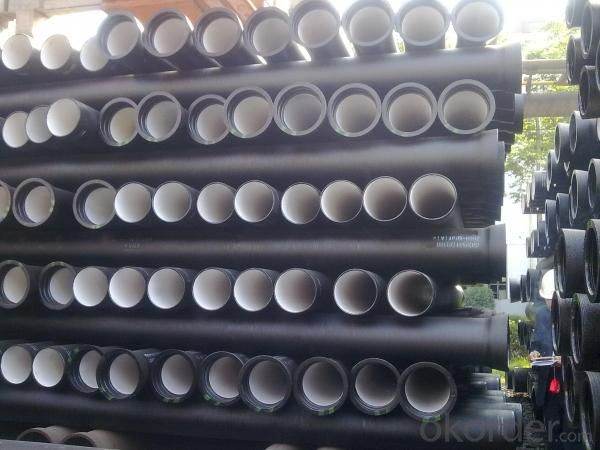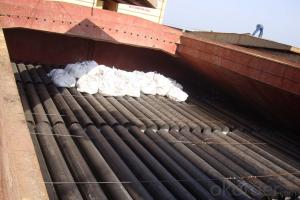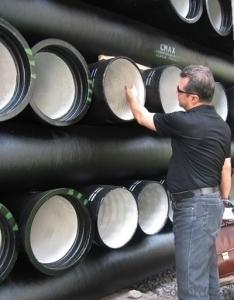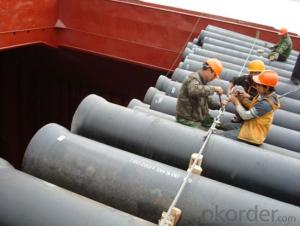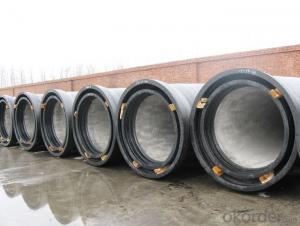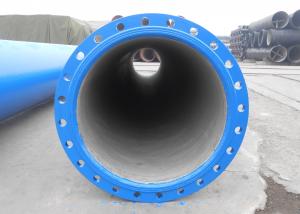Mechnical Joint K Type Ductile Iron Pipe
- Loading Port:
- China Main Port
- Payment Terms:
- L/C,D/A,D/P,T/T
- Min Order Qty:
- 1 Metric Ton m.t.
- Supply Capability:
- 300000 Metric Tons per Year m.t./month
OKorder Service Pledge
OKorder Financial Service
You Might Also Like
General introduction of Mechanical Joint K Type Ductile Iron Pipe
•Material: Ductile Cast Iron
•Size Range: DN 80mm to DN 2000mm
•Unit Effective Length: 5.7m or 6m or negotiable
•Manufacture Standard: ISO 2531:1998/ EN 545:2006/EN 598:2007
•Annual capacity: 300,000 tons
• Internal lining: cement mortar lining comply with ISO4179.
External coating: sprayed metallic Zinc coating (min.130g/m2) according to ISO8179 + bitumen painting (min.70μm) according to BS3416.
Gasket: Matched 100% natural rubber gasket in accordance with ISO4633.
•Special requirements on external coating and internal lining can be applied
•We also provide accessories such as SBR/EPDM rubber gaskets, lubricant paste, pipe caps, PE sleeves, etc.
Features of Ductile Iron Pipes:
Ductile iron pipes is stronger and easier to tap, requires less support and provides greater flow area compared with pipes made from materials like PVC, concrete, polyethylene, or steel.
Application:
Used for water and sewer lines.
Specification of Mechanical Joint K Type Ductile Iron Pipe:
Standard wall thickness of Mechanical Joint K Type Ductile Iron Pipe
|
Nominal Diameter |
Wall Thickness(mm) | ||||||
|
DN(mm) |
Pipe |
Fittings | |||||
|
Class C |
K8 |
K9 |
K10 |
K12 |
K12 |
K14 | |
|
80 |
4.4 |
6 |
6.0 |
7 |
8.1 | ||
|
100 |
4.4 |
6.0 |
7.2 |
8.4 | |||
|
125 |
4.5 |
6.3 |
7.5 |
8.8 | |||
|
150 |
4.5 |
6.3 |
7.8 |
9.1 | |||
|
200 |
4.7 |
6.3 |
8.4 |
9.8 | |||
|
250 |
5.5 |
6.8 |
7.5 |
9 |
9 |
10.5 | |
|
300 |
6.2 |
6.4 |
7.2 |
8 |
9.6 |
9.6 |
11.2 |
|
350 |
6.3 |
6.8 |
7.7 |
8.5 |
10.2 |
10.2 |
11.9 |
|
400 |
6.5 |
7.2 |
8.1 |
9 |
10.8 |
10.8 |
12.6 |
|
450 |
6.9 |
7.6 |
8.6 |
9.5 |
11.4 |
11.4 |
13.3 |
|
500 |
7.5 |
8 |
9 |
10 |
12 |
12 |
14 |
|
600 |
8.7 |
8.8 |
9.9 |
11 |
13.2 |
13.2 |
15.4 |
|
700 |
8.6 |
9.6 |
10.8 |
12 |
14.4 |
14.4 |
16.8 |
|
800 |
9.6 |
10.4 |
11.7 |
13 |
15.6 |
15.6 |
18.2 |
|
900 |
11.6 |
11.2 |
12.6 |
14 |
16.8 |
16.8 |
19.6 |
|
1000 |
12.6 |
12 |
13.5 |
15 |
18 |
18 |
21 |
|
1200 |
13.6 |
13.6 |
15.3 |
17 |
20.4 |
20.4 |
22.8 |
|
1400 |
15.7 |
15.2 |
17.1 |
19 |
22.8 |
22.8 |
26.6 |
|
1500 |
16.7 |
16 |
18 |
20 |
24 |
24 |
31 |
|
1600 |
17.7 |
16.8 |
18.9 |
21 |
25.2 |
25.2 |
29.4 |
|
1800 |
19.7 |
18.4 |
20.7 |
23 |
27.6 |
27.6 |
32.2 |
|
2000 |
21.8 |
20 |
22.5 |
25 |
30 |
30 |
35 |
Mechanical Joint K Type
The mechanical joint is a bolted joint utilizing a ductile iron gland and mechanical joint gasket. The mechanical joint is recommended for water service where many connections are required. All components of the mechanical joint are interchangeable. The spigot end of mechanical joint pipe has the same outside diameter as push-on joint pipe. As a result, it can be fitted into such joints in the field by beveling the outside edge. All of the accessories (glands and fasteners) are supplied with each joint.
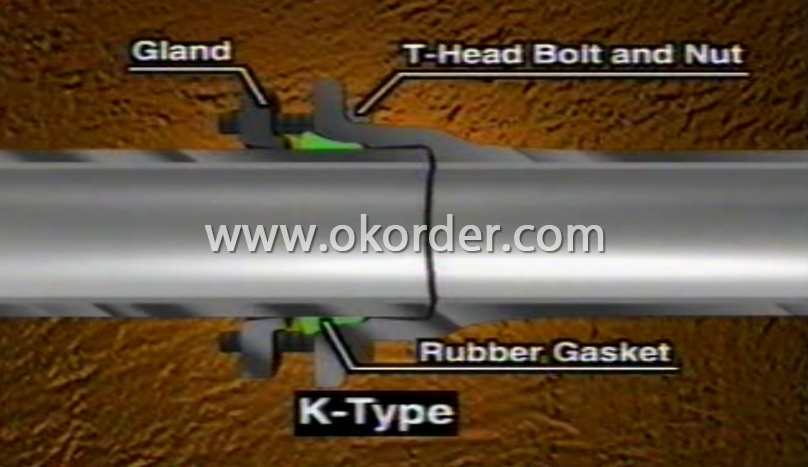
Nominal Diameter DN of Mechanical Joint K type Ductile Iron Pipe
|
Nominal Diameter DN |
mm |
Holes No. | |||
|
DE |
D1 |
D |
T | ||
|
100 |
118 |
186 |
232 |
80 |
4 |
|
150 |
170 |
241 |
287 |
80 |
6 |
|
200 |
222 |
292 |
338 |
80 |
6 |
|
250 |
274 |
348 |
394 |
80 |
8 |
|
300 |
326 |
399 |
445 |
110 |
8 |
|
350 |
378 |
458 |
504 |
110 |
10 |
|
400 |
429 |
512 |
558 |
110 |
12 |
|
500 |
532 |
618 |
664 |
110 |
14 |
|
600 |
635 |
725 |
771 |
110 |
14 |
|
700 |
738 |
839 |
893 |
120 |
16 |
|
800 |
842 |
942 |
996 |
120 |
20 |
|
900 |
945 |
1052 |
1118 |
120 |
20 |
|
1000 |
1048 |
1160 |
1226 |
130 |
20 |
|
1200 |
1255 |
1372 |
1438 |
130 |
28 |
|
1400 |
1462 |
1591 |
1657 |
130 |
28 |
|
1600 |
1668 |
1790 |
1856 |
160 |
30 |
|
1800 |
1675 |
1996 |
2062 |
170 |
34 |
|
2000 |
2082 |
2216 |
2282 |
180 |
36 |
Handling and Transportation of Ductile Iron Pipe Mechnical Joint K Type.
Hoisting
Take precaution of handling pipe with steel cable, hoisting belts and specialized rigging avoiding from pipe's rocking. While using steel cable, single cable is not admitted, for the purpose of protecting outer anti-corrosion layer, steel cable should be packed by rubber or other similar material. While using hook, it also should be covered with rubber or other similar material for protecting cement lining layer. Especially for pipe with relative large diameter, hook should be mounted a gasket with same shape as internal diameter of pipes while handling. It is not available fixing hook on the steel belts or socket side and spigot side of pipe while handling pipes in bundle.
Transportation
Put two pieces or more woods on the platform of the vehicle while transporting, pipes are laid on the wood and fixed by wedge. The part over the vehicle body should not be more than 1/4 of overall length of pipe. If pipes are piled up more than one layer, each layer of pipes should reverse, and buffering rubber or gasket should be put on the space between two layers of pipes, at last pipes are fixed up with steel cable and buffering gasket. Check often if pipes can fall out during conveying, and check if stop wedge is not hard up. The vehicle should slow down on the uneven road or while swerving.
Storage
Under pipes there should be put wedge or crosstie while stacking pipes, and socket and spigot of pipes should be interleaved and on the stop wedge in cast of pipe's rolling. Uneven and serious polluted ground, or slope and marshy are not available.
Pictures Show of Mechanical Joint K Type Ductile Iron Pipe
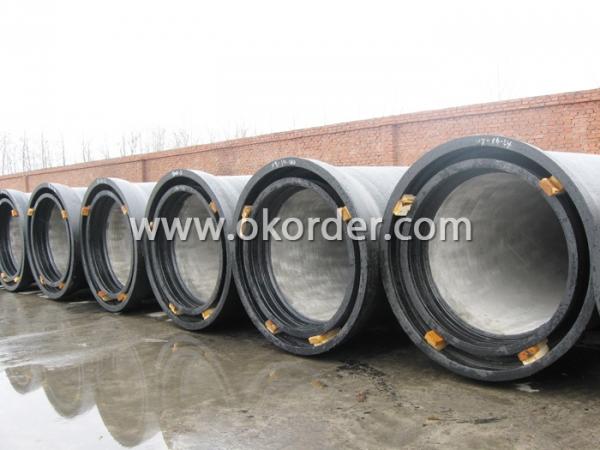
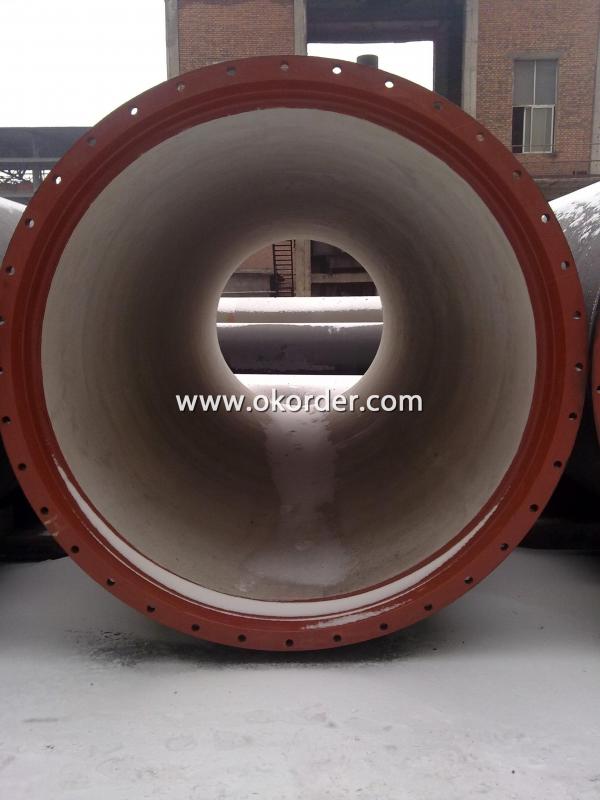
If any questions, please feel free to contact us.
- Q: How do ductile iron pipes handle extreme temperatures?
- Ductile iron pipes, known also as cast iron pipes, possess the ability to effectively handle extreme temperatures. The material composition of ductile iron enables it to endure both high and low temperatures without experiencing significant damage or degradation. When exposed to high temperatures, ductile iron pipes demonstrate exceptional thermal resistance, rendering them suitable for applications involving the transportation of hot liquids or gases. The high melting point of ductile iron, ranging from 2060°C to 2200°C, guarantees that the pipes can withstand extreme heat without melting or distorting. Consequently, these pipes are ideal for utilization in industries such as oil and gas, steam distribution, and high-temperature water supply systems. Likewise, ductile iron pipes exhibit satisfactory performance in low-temperature environments. They possess a low coefficient of thermal expansion, thereby enabling them to endure the expansion and contraction that occurs during temperature fluctuations without cracking or fracturing. This quality makes them appropriate for use in cold climates or in applications involving the transportation of chilled liquids or gases. Furthermore, ductile iron pipes possess excellent thermal conductivity, allowing them to efficiently dissipate heat. This characteristic proves particularly significant in high-temperature applications where effective heat transfer is vital to prevent damage to the pipes or the materials being transported. In conclusion, ductile iron pipes effectively handle extreme temperatures due to their high melting point, low coefficient of thermal expansion, and exceptional thermal conductivity. These attributes establish them as a dependable choice for various applications involving extreme temperature conditions.
- Q: Are ductile iron pipes resistant to chemicals or solvents?
- Ductile iron pipes are generally resistant to a wide range of chemicals and solvents. This is due to their composition, which includes a high percentage of iron and carbon, along with small amounts of other alloying elements like silicon, manganese, and magnesium. These alloying elements contribute to the overall strength and durability of ductile iron pipes, making them highly resistant to corrosion and chemical attack. However, it is important to note that the resistance of ductile iron pipes to chemicals and solvents can vary depending on the specific substance and its concentration. Some aggressive chemicals or solvents, particularly those with high acidity or alkalinity, may cause gradual corrosion or degradation of the pipe material over time. In such cases, it is advisable to consult with the pipe manufacturer or a professional engineer to ensure the compatibility of the pipe with the specific chemicals or solvents being used. Additionally, proper installation and maintenance practices play a crucial role in maintaining the chemical resistance of ductile iron pipes. Regular inspection, cleaning, and protective coatings can help to prolong the lifespan and performance of the pipes in the presence of various chemicals or solvents.
- Q: DN1800 can the length of ductile iron pipes be several meters? What is the total weight?
- Ductile iron pipe is a kind of cast iron pipe.
- Q: Are ductile iron pipes suitable for irrigation canal systems?
- Absolutely, irrigation canal systems can indeed benefit from the use of ductile iron pipes. These pipes have gained recognition for their exceptional robustness and durability, rendering them exceptionally well-suited for withstanding the immense pressure and load demands of irrigation canal systems. They exhibit remarkable resistance to external forces, such as heavy machinery, and can effortlessly endure the stresses caused by soil movement and settlement. Moreover, ductile iron pipes boast remarkable resistance to corrosion and feature a flawlessly smooth inner surface. This smoothness significantly reduces friction and ensures a highly efficient flow of water. This particular quality is of utmost importance in irrigation systems, as it enables the effective distribution of water to crops, thereby guaranteeing their optimal growth and yield. Furthermore, ductile iron pipes boast an impressively long lifespan, often exceeding a century. This longevity makes them a truly cost-effective option for irrigation canal systems. Additionally, their minimal maintenance requirements further enhance their suitability for this particular application. Ultimately, ductile iron pipes possess all the essential characteristics necessary for irrigation canal systems, including strength, durability, corrosion resistance, and efficiency. As such, they represent a highly fitting choice for the purpose at hand.
- Q: Why does the cast iron pipe always run off when testing?
- If the pipe is exposed for pressure test, you must add a pier, or else the fittings fly out. You are not surprised. At the same time, the pressure test before the ink tube to make full immersion bubble discharge clean, or a big easy gas pressure pipe explosion.
- Q: Are ductile iron pipes suitable for deep burial installations?
- Indeed, deep burial installations can accommodate ductile iron pipes. These pipes possess remarkable strength and endurance, rendering them highly suitable for subterranean purposes. They possess the ability to withstand the immense pressure exerted by soil as well as any external forces that may arise. Moreover, ductile iron pipes exhibit exceptional resistance to corrosion, a vital characteristic for ensuring long-lasting performance in buried settings. Furthermore, their flexibility enables them to endure ground movements and settle without fracturing. All in all, ductile iron pipes represent a dependable and economically efficient option for deep burial installations.
- Q: How does ductile iron pipe perform in areas with high seismic activity?
- Ductile iron pipe is known for its exceptional strength and durability, which makes it well-suited for areas with high seismic activity. Seismic events, such as earthquakes, can subject pipelines to significant stress and strain, causing them to rupture or fail. However, ductile iron pipe has the ability to withstand these dynamic forces due to its unique material properties. One of the key advantages of ductile iron pipe in seismic areas is its superior flexibility. Unlike rigid materials such as cast iron or steel, ductile iron has a higher degree of elasticity, allowing it to deform and absorb energy during seismic events. This flexibility helps to dissipate the seismic forces, reducing the risk of pipe failure and minimizing damage to the overall pipeline system. Moreover, ductile iron pipe is manufactured with a high level of ductility, meaning it can undergo considerable deformation without fracturing. This property is crucial in seismic zones as it enables the pipe to withstand ground movements and seismic waves without compromising its structural integrity. The ability of ductile iron to absorb and redistribute stress also helps to prevent localized failures, ensuring the overall stability and reliability of the pipeline system. Additionally, ductile iron pipe is highly resistant to corrosion, which is especially important in high seismic areas where the integrity of the pipe may be compromised by ground movement and subsequent water leaks. The corrosion resistance of ductile iron ensures the longevity and reliability of the pipeline system, reducing the risk of leaks or failures during seismic events. In conclusion, ductile iron pipe performs exceptionally well in areas with high seismic activity due to its superior flexibility, high ductility, and corrosion resistance. These properties allow the pipe to withstand the dynamic forces generated during seismic events, providing a reliable and long-lasting solution for transporting fluids and ensuring the safety of communities in earthquake-prone regions.
- Q: Can ductile iron pipes be used in coastal or marine environments?
- Yes, ductile iron pipes can be used in coastal or marine environments. Ductile iron is a type of cast iron that has been treated with magnesium to give it enhanced strength, ductility, and resistance to corrosion. This makes it suitable for use in environments with high levels of moisture, such as coastal or marine areas. Coastal and marine environments are known for their high levels of saltwater, which can cause corrosion in metal pipes. However, ductile iron pipes have excellent corrosion resistance due to their protective coating. This coating acts as a barrier between the pipe and the corrosive elements present in saltwater, preventing the formation of rust and extending the lifespan of the pipes. Furthermore, ductile iron pipes can withstand the high pressures and stresses associated with coastal and marine applications. They have a high tensile strength, allowing them to handle the weight of soil, rocks, and other materials that may be present in these environments. Additionally, ductile iron pipes are resistant to damage from external forces, such as waves or debris, making them a reliable choice for coastal or marine projects. In summary, ductile iron pipes are a suitable choice for coastal or marine environments due to their corrosion resistance, high tensile strength, and durability. They can reliably transport water or other fluids in these challenging environments while maintaining their structural integrity over an extended period of time.
- Q: Are there any limitations to the length of ductile iron pipe sections?
- Yes, there are limitations to the length of ductile iron pipe sections. The length of ductile iron pipe sections is typically limited due to practical considerations such as transportation, installation, and handling. Longer pipe sections can be more difficult to transport and maneuver, especially in areas with limited access or challenging terrain. Additionally, longer pipe sections may be more prone to damage during installation, as they can be more difficult to align and join properly. There are also limitations in terms of manufacturing capabilities. Ductile iron pipes are typically manufactured in standard lengths, which can vary depending on the manufacturer and the specific application. These standard lengths are typically designed to balance the needs of transportation, installation, and the overall performance of the pipe. Furthermore, longer pipe sections may pose challenges in terms of expansion and contraction due to temperature variations. Ductile iron pipes are susceptible to thermal expansion and contraction, and longer sections may experience greater stress and strain as a result. Therefore, while there is no absolute limit to the length of ductile iron pipe sections, practical considerations and manufacturing capabilities often result in the use of standard lengths that balance various factors such as transportation, installation, and performance.
- Q: Can ductile iron pipe be used for water distribution systems in cold climates?
- Yes, ductile iron pipe can be used for water distribution systems in cold climates. Ductile iron has excellent resistance to freezing and can withstand extreme cold temperatures without becoming brittle or cracking, making it a suitable choice for water distribution systems in cold climates.
1. Manufacturer Overview
| Location | Henan, China |
| Year Established | 1958 |
| Annual Output Value | Below US$1 Million |
| Main Markets | Mid East, Africa, South Asia, Eastern Asia |
| Company Certifications | ISO 9001:2008;ISO2531:2000 |
2. Manufacturer Certificates
| a) Certification Name | |
| Range | |
| Reference | |
| Validity Period |
3. Manufacturer Capability
| a) Trade Capacity | |
| Nearest Port | Tianjin; Qingdao |
| Export Percentage | 1% - 10% |
| No.of Employees in Trade Department | 3000 People |
| Language Spoken: | English; Chinese; Spain; Alabic |
| b) Factory Information | |
| Factory Size: | Above 150,000 square meters |
| No. of Production Lines | Above 6 |
| Contract Manufacturing | OEM Service Offered; Design Service Offered |
| Product Price Range | Average |
Send your message to us
Mechnical Joint K Type Ductile Iron Pipe
- Loading Port:
- China Main Port
- Payment Terms:
- L/C,D/A,D/P,T/T
- Min Order Qty:
- 1 Metric Ton m.t.
- Supply Capability:
- 300000 Metric Tons per Year m.t./month
OKorder Service Pledge
OKorder Financial Service
Similar products
Hot products
Hot Searches
Related keywords



